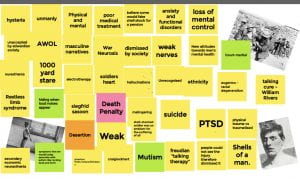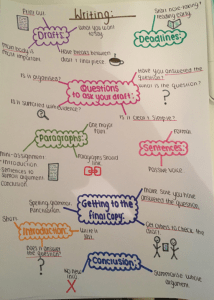By Conor Penna-FitzGerald (University of Roehampton)
My name is Conor Penna-FitzGerald and I am a postgraduate history student at the University of Roehampton. My project analysed how students experienced online learning during the pandemic in comparison to the ‘normal’ classroom experience.
Starting my research for this post, I had thought there would be an abundance of views and opinions on online learning to be found online. In reality, I was amazed at how little there was. On ‘The Student Room’, I found only two forums, both of which emphasised limited access to primary sources, as well as other learning resources, such as course readings. Instead, I conducted my own research and spoke to nine UK-based History students (all postgraduates) on their experiences of online seminars, the predominant teaching method adopted by universities during the COVID-19 pandemic. These offered mixed views on the value of online seminars over the usual classroom experience.
The most consistent positive response was that of praise for the history faculty at their university. Not only have they have provided high levels of support and adapted quickly to the changing circumstances, but they have helped to establish a sense of normality. By keeping to a clear schedule, lecturers have helped to mitigate feelings of discontent amongst students. They have also taken on extra responsibilities in terms of providing psychological aid, providing reassurance about student’s abilities. Furthermore, their willingness to use new technology is commendable. Ultimately, history lecturers have clearly maintained a high level of professionalism, which has positively shaped student experiences.
One of the most important positives of this situation, is that commuting is no longer an issue. Many of the students I spoke to were commuting students, and their strenuous, long, exhausting journeys have now been diminished. Not only has online learning made it easier to attend seminars, but much cheaper. One international student shared this sentiment: it is easier for them to stay in their home country and study, much cheaper, and more familiar. Another UK-based postgraduate student emphasised that not needing to commute made her feel much safer. She is reliant on public transport as she does not own a car, and with seminars often taking place in the evening, ‘Zoom’ seminars have worked well. This suggests that when pandemic restrictions do ease, universities should consider continuing their offering of online learning, as it ensures access to higher education for people with physical and mental health problems (e.g. anxiety). It allows students to bypass social insecurities that come from physical presence, enabling them to reach their full potential in a safer and more comfortable environment.
To my surprise, only one person I spoke to mentions the benefits of pre-recorded lectures. The reason why I was shocked by this is because they can now be watched at any time. This allows flexibility for students and allows them to study at their own pace. If students do not understand any content, they can pause the video and re-watch it until they understand it.
Despite these positives, online seminars have been much more divisive in terms of student experience. Many of the issues with them have been clear since the beginning of the pandemic. One of the factors which can ‘make or break’ the student experience is their internet connection, and most of the students I spoke to confirmed this. Buffering, pixilation, ‘robotic’ sounding voices, and eventual disconnection from seminars have all posed challenges. These disrupt focus, cause a loss of motivation, and ultimately dampen the online learning experience. I suffer from bad internet and have needed to turn off the webcam to increase the bandwidth, or dial into the seminar by phone. I often chose the latter option, leading to a virtually non-existent social experience due to not being able to see the other students.
To further illustrate this, the image to the right is a screenshot of what ‘dialling in’ to a ‘Zoom’ meeting looks like. As can be seen, it is like that of a normal phone call. This has contri buted to an atmosphere which has been totally ‘unlike’ university, and for those who do have to dial in, it unfortunately permits the emergence of solitary emotions due to the lack of community. Even students who have been able to engage with a webcam have felt the same.
buted to an atmosphere which has been totally ‘unlike’ university, and for those who do have to dial in, it unfortunately permits the emergence of solitary emotions due to the lack of community. Even students who have been able to engage with a webcam have felt the same.
As social interaction has been minimal, communication between students has suffered. One student commented that online learning has been disappointing because of the inability to freely communicate with their peers about what they really thought about the readings, as well as how assignments and dissertations were progressing. This has added feelings of what I call ‘assignment isolation’ (undertaking stressful and demanding work completely on your own), which was seldom there when students were physically present together in class.
In addition to this, online learning has made it easier for students to fall behind. It has been much harder for students to ask questions about lectures that have been pre-recorded and uploaded online. If a student needs clarification, they must take the time to email their lecturer and wait for their response. Students who dial into seminars to ask questions are also unable to use any ‘raise hand’ functions. Again, students would then have to email their lecturer after class and once again wait for their response. The online teaching format additionally (although inadvertently) allows for procrastination, due to recordings being available to watch anytime. It therefore requires the student to exercise more discipline over their time, which before the pandemic would have been structured in a clear university timetable.
Many of the problems described here reflect wider issues associated with the lockdowns and remote working, and so ways of combatting them are unclear. Nevertheless, even small steps could improve the student experience of university. If the student uses wireless internet, for example, the purchase of an ethernet cable would result in a much more stable internet connection. These cables vary in expense but are typically rather cheap! Moreover, for students who feel that university is now ‘no longer like university’, a group chat could go a long way in helping maintain contact with their peers. This would not only aid social interaction, but also allow students to discuss and assist each other in their assignments, reading, and dissertations. In this way, even if online learning is not seen as effective as campus-based learning, it does serve a purpose.
We’d like to thank Conor for sharing the results of his research into how the pandemic has affected History students and would love to hear more from academics and their students, either on this blog or via Twitter @history_uk – get in touch if you’d like to have your say.
We’re currently collecting feedback on the Pandemic Pedagogy Handbook and would encourage you to fill in the survey here.
In addition, we’ll soon be announcing a follow-up project on pedagogy after the pandemic. So watch this space!





You must be logged in to post a comment.